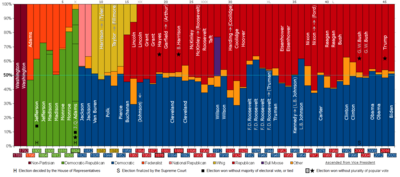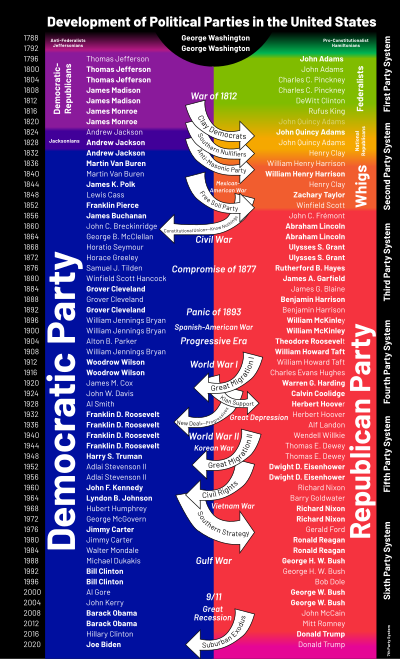| Part of a series on the |
| Political eras of the United States |
|---|



Political eras of the United States refer to a model of American politics used in history and political science to periodize the political party system existing in the United States.
The United States Constitution is silent on the subject of political parties. The Founding Fathers did not originally intend for American politics to be partisan. In Federalist Papers No. 9 and No. 10, Alexander Hamilton and James Madison, respectively, wrote specifically about the dangers of domestic political factions. In addition, the first President of the United States, George Washington, was not a member of any political party at the time of his election or throughout his tenure as president.[1] Furthermore, he hoped that political parties would not be formed, fearing conflict and stagnation, as outlined in his Farewell Address.[2]
Generally, the political history of America can be divided into five hegemonic eras, which can be further divided into seven party systems which each follow a realignment. The political hegemonic eras are:
- 1789[a]–1801: Federalist Era, dominated by the liberal-leaning Federalists, and their predecessors the Pro-Administration Faction, both based in the Northern United States. Pro-Administration Faction/Federalists have the full trifecta of government (they control the House and Senate in Congress and the Presidency) for 8 years of this period, while government was divided (between the House and Senate in Congress and/or the Presidency) for 4 years.
- 1801[b][c]–1861: Democratic Era, dominated by the conservative-leaning Democrats, and their predecessors the Democratic-Republicans, both based in the Southern United States to non-coastal North. Democratic-Republicans/Democrats have the full trifecta of government for 38.5 years of this period, government was divided for 20.5 years[d], and Whigs had a trifecta for 1 year.
- 1861[e]–1933: Republican Era, dominated by socially liberal, economically conservative Republicans based in New England and the Great Lakes Region (and later the greater Rust Belt region and the Midwestern United States). Republicans have the full trifecta of government for 36–40 years[f] of this period (depending on the inclusion of Andrew Johnson's term[g] and the 1881-83 Senate term[h]), government was divided for 24–28 years[i], and Democrats had a trifecta for 8 years[j].
- 1933[k]–1969: New Deal Democratic Era, dominated by a coalition of socially conservative Dems based in the South and economically progressive Dems based in the greater Rust Belt region, the Sun Belt and the West Coast of the United States. This marks the beginning of the "party switch" – liberals in the North and Urban Cities slowly flip Democratic. Democrats have the full trifecta of government for 26 years, government was divided for 8 years[l], and Republicans had a trifecta for 2 years[m].
- 1969[o]–Present: Divided Government Era, where the Federal Government is commonly divided (between Presidency and/or Congress) between liberal Democrats based in the North and West Coast & conservative Republicans based in the Midwest and South. This marks the finalization of the "party switch" – conservatives in the South and Rurals slowly flip Republican. As of November 2024, divided government has occurred for 40 years of this period[p], Democrats had a trifecta for 10 years[q], and Republicans held a trifecta for 6 years.
The seven party systems and their realignments which take place within these hegemonic eras are described in detail below:
- ^ Chambers, William Nisbet (1963). Political Parties in a New Nation.
- ^ Washington's Farewell Address

- ^ "Congressional Record, March 1801" (PDF). Congressional Record: 147–151. March 1801.
- ^ "Explanation of the Types of Sessions of Congress". The Green Papers. June 2001.
Cite error: There are <ref group=lower-alpha> tags or {{efn}} templates on this page, but the references will not show without a {{reflist|group=lower-alpha}} template or {{notelist}} template (see the help page).
